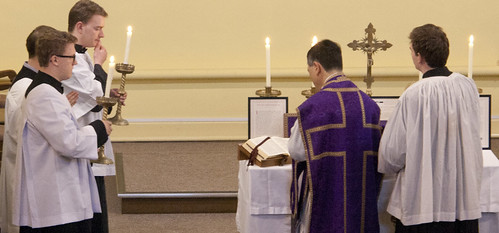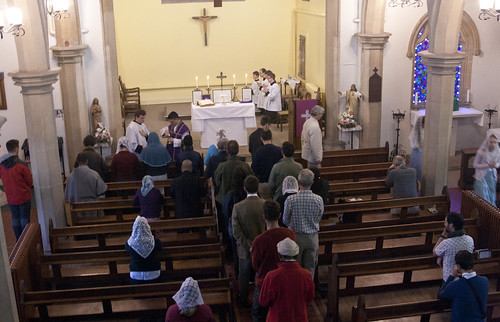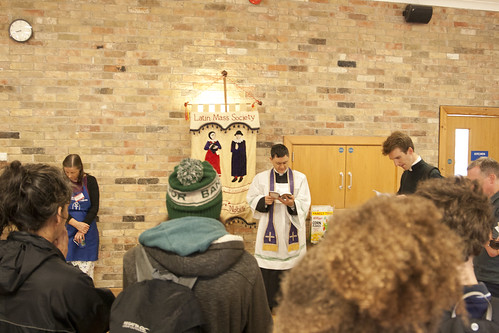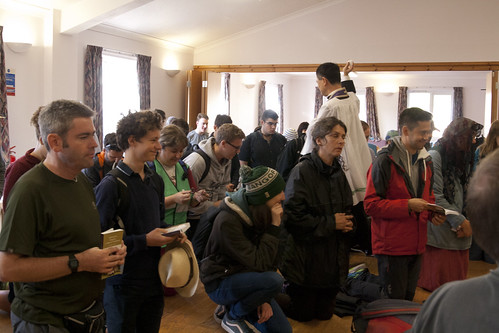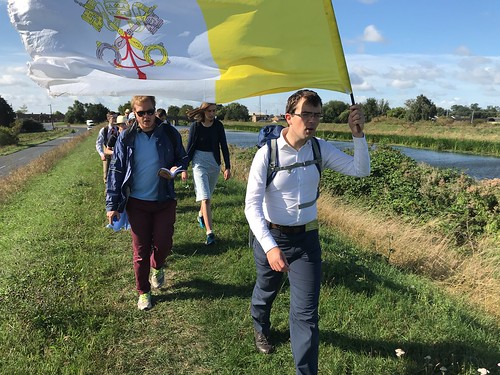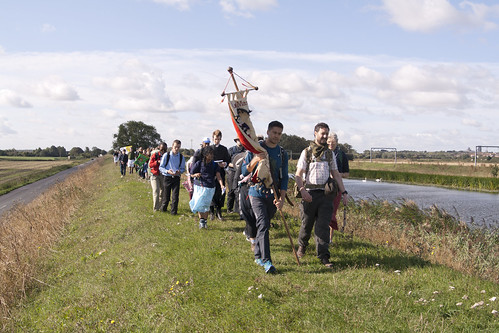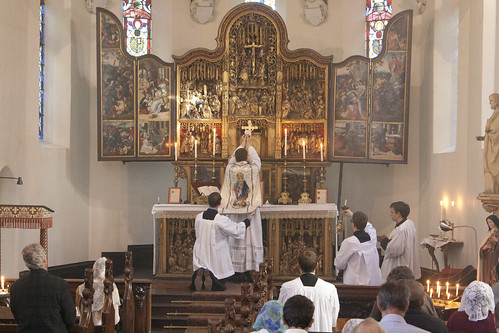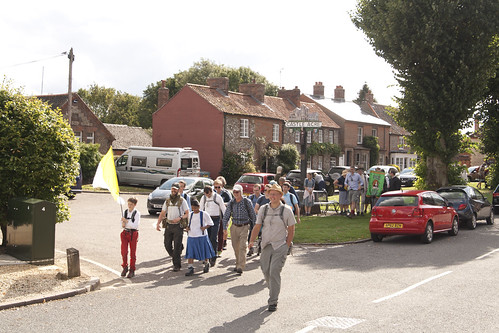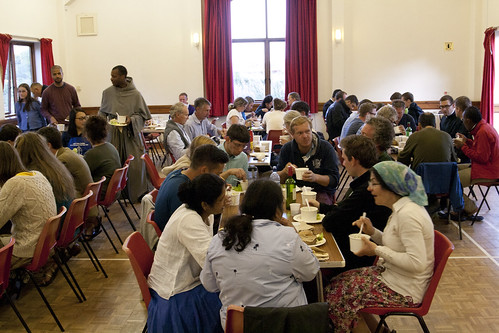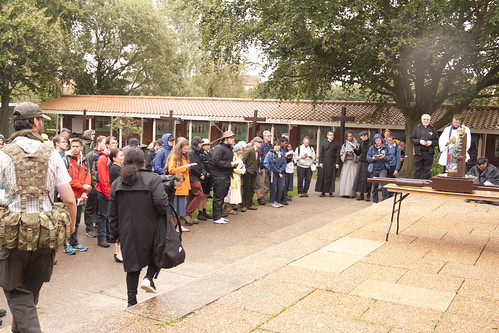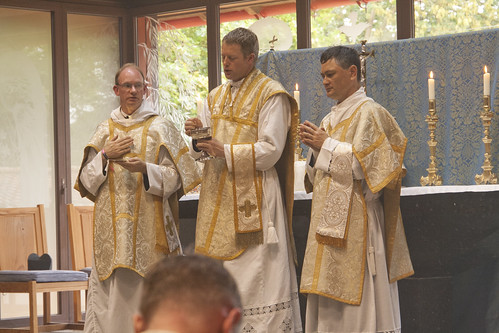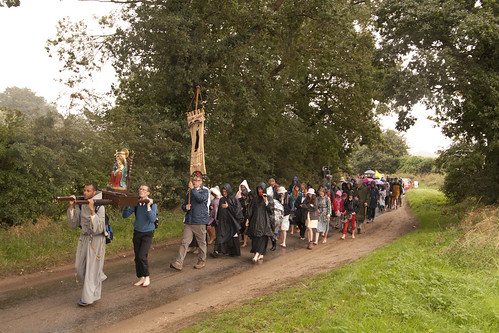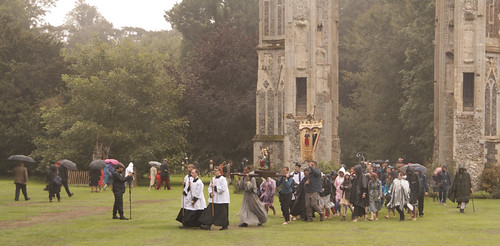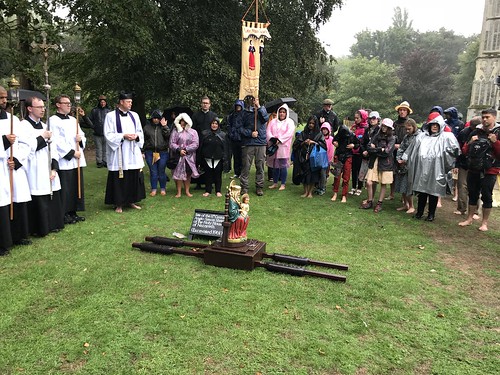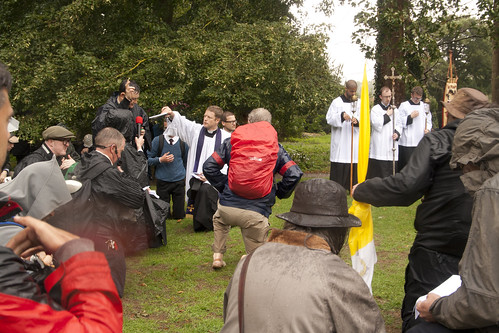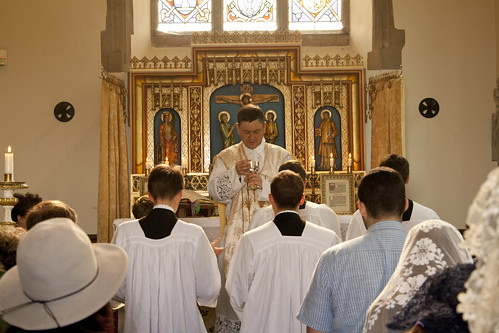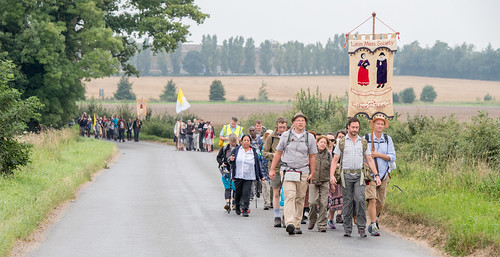Chairman's Blog
Fr Francis Doyle and St Mary Magdelen
Last weekend I had the following letter to the Catholic Universe printed (last weekend's edition). They cut out the last line, which I've put in bold below, but then you can't have everything.
Sir,
I must take issue with Fr Francis Doyle (Questions and Answers, 14th Sept), who dismisses the traditional identification of the 'sinner' who anointed Jesus' feet with nard with Mary of Bethany and with Mary Magdalen, as a mere 'confusion'. No doubt he would be equally dismissive of the further identification of Mary Magdelen with the 'woman taken in adultery'.
The Latin Fathers of the Church held that these people are the same, and this view has become embedded not only in art, but in the liturgy. In the pre-1969 calendar the feast of St Martha (29th July) is the octave of the feast of her sister St Mary Magdalen (22nd), and in the Dies irae, sung at Masses for the dead, the penitent sinner forgiven by our Lord is called 'Mary'.
Should the views of the Fathers and the testimony of the ancient liturgical tradition, be dismissed out of hand? The Second Vatican Council certainly thought not, directing that future translations of the Psalms conform to 'the entire tradition of the Latin Church' (Sacrosanctum Concilium 91). The 2001 Instruction Liturgicam authenticam notes similarly that translations should reflect the 'understanding of biblical passages which has been handed down by liturgical use and by the tradition of the Fathers of the Church .'
Fr Doyle owes this view of St Mary Magdalen a little more respect.
Yours faithfully,
I've written on this specific issue in more detail here.
Support the work of the LMS by becoming an 'Anniversary Supporter'.
The abuse crisis: too little authority, not too much
 |
| Abraham, our Patriarch |
A letter to The Tablet, which they have apparently chosen not to print.
Sir
As a former Ampleforth pupil (1985-90), I share the disgust of your leader, feature article, and letters page (18 August). I think the various references to the ‘patriarchal’ Benedictine leadership model are in danger of confusing the issue, however.
If one wishes to discover the traditional, patriarchal attitude to criminal behaviour, consider the early Roman hero Brutus when, on the eve of battle, his sons were accused of treason. He executed them.
The Christian model of leadership does not endorse Brutus’ savagery, but it does stress a leader’s role in governing for the good of the community. This is the kind of government of a patriarchal family we find described in Proverbs, and modelled by saintly reforming Abbots, Bishops, and Kings in the Christian centuries. They would all have been appalled at the idea that their role had anything to do with giving criminals further opportunities to commit their crimes.
What we find described in the IICSA report into Downside and Ampleforth is not the rule of a ‘father in God’ inspired by a traditional conception of God himself. Rather, we see the influence of a modern conception of a ‘God without wrath’, a senile and indulgent grandfather. The problem is not the Benedictine model of leadership: the problem is the corruption of that model.
Yours faithfully,
Joseph Shaw
My letter was addressed to the question, treated by the leader and feature articles, of the relationship between the Abbots of these abusive monasteries and their monks. The idea that the problem in these communities was that the Abbots were too harsh on their monks is a sick liberal fantasy. When it came to dealing with abusers, those in authority were all meek and indulgent. One said to me once, when I suggested that an abuser with an alcohol problem be told to give up: 'Oh no, to be effective it must come from him.'
Support the work of the LMS by becoming an 'Anniversary Supporter'.
Attacking the whistleblower: the abuse-enabling culture is alive and well
Something profoundly worrying about criticisms of the signatories of the Correction specifically for speaking out about problems which every informed Catholic already knows about, is the mindset it reveals, one focused not on the truth, but on appearances. It is strongly reminiscent of the mindset at work in abusive families, where children are taught to pretend things are all right, when they are not: certain topics are not to be broached, certain facts are not to be referred to. This attitude can be enforced not by the abusive parent directly, but by other family members who are trying to keep up appearances and hold the family together. It is nevertheless profoundly unhealthy, and indeed is linked to psychological disorders in the children.
We should fear any such attitude, however well-intentioned, invading the Church. If there are problems, we should talk about them, and not pretend they do not exist.
It is natural to ask whether, since Cardinal McCarrick was himself a sexual predator, those who defend him, and often had such long associations with him, are or have been sexual predators as well. It is after all very possible. But even if some are, I expect most are not. They stand in relation to McCarrick as many family members stand in relation to an abusive parent. They desperately try to protect him, not because they approve of what he does, but because they are terrified of the consequences of it all coming out. They are frightened that the exposure of the abuser will destroy the family.
That specific fear is not, of course, entirely irrational, but the behaviour of these family members is not to be understood in simple, rational terms. They are, after all, victims of the abuse, whether sexual or psychological, and this has shaped their behaviour in non-rational ways. To put it in crude terms, they have for years and perhaps decades been bullied and brainwashed by the abuser, and the complex and self-contradictory message the abuser has sought to impress upon them includes the following: the abuser does no wrong; they are at fault for bad things which are happening; they are guilty and should fear the attention of outsiders; the abuser loves them and protects them; and terrible things would happen if he were removed from the scene.
Those who have internalised this message can go to astonishing lengths to protect the person who is making their lives hell, and to maintain the situation in which his behaviour can continue.
An added factor, particularly when we move from families to larger institutions, is when the abuser is able to promote favoured victims to the status of co-abuser, or give them other privileges which depend upon the continuing existence of the abusive system.
It is worth emphasising that I am talking about abuse, not what the secular press likes to call 'consensual relationships with adults'. Abuse does not stop being abuse when the victim turns 18, but the pattern of behaviour I am describing has little in common with, say, a seminarian having an affair with a fellow seminarian, or a woman outside the seminary, serious as that would be. Nor am I principally concerned with sexual orientation: the pattern of behaviour can equally be displayed when the underlying abuse is not sexual at all, but psychological. My interest here is the relationship between what we might call the core abuse and the penumbra of unhealthy attitudes and patterns of behaviour which come to be displayed by those around the abuser, even by people who don't take part in the core abuse.
For these attitudes and patterns of behaviour in the circle around the abuser are themselves abusive.
Imagine a family or institution at whose apex there is a classic abuser. He has surrounded himself with people who permit, facilitate, and cover up the abuse, and placed them in positions of privilege. Beyond this inner circle there will be people who have not been completely conditioned by the abuse, for example because they are newer on the scene, or younger. Most of them will have much more contact with the inner circle than with the abuser himself. It is the inner circle who will do much, or perhaps even all, of the direct work of bullying and brainwashing these outer-circle people, who will be looking to them for guidance. Consistently turning a blind eye to abuse, refusing to talk about it, becoming angry when certain topics are broached: these are powerful tools, if applied consistently to a captive audience over a long period of time. They train the junior members of the institution or family in the behaviour which is expected of them. This is a training in patterns of thought and behaviour which are unhealthy: which are harmful to mental health. They are gaslighting them.
This will work most profoundly in a closed institution like a cult, but it can work in families, seminaries, dioceses, the whole Church, and indeed in a whole society. The more open the institution the harder it will be for a culture of abuse to distort members' sense of justice and of what is normal, but it can still work to a large extent. This is how totalitarian states can continue to exist.
The most important thing for abuse-facilitators to do is to keep a lid on the exchange of information and dissent. This is a very pronounced principle in many cults, and of course in repressive states. In institutions and families which have limited coercive measures to employ against members, social pressure is the key to this. People who speak out internally or seek to attract the attention of outsiders are subjected to vilification and ostracism. Abusive institutions are generally also on the look-out for scapegoats to blame for their poor functioning, so hysterical attacks on whistleblowers can serve a double purpose.
The people attacking the whistleblowers are, to repeat, not necessarily the top-level abusers in the institution. They are people who are both abused and abuser: who are inflicting on others what they fear will happen to themselves. At the limit, we might want to absolve them from blame altogether: they may be too terrified and pyschologically damaged to think straight. But my concern is not with Maoist China; I'm talking about something at the milder end of the range. The Church is a dysfunctional family, not a death-cult. The unbalanced attacks on Archbishop Viganò, the desperate attempts to change the subject, are not being carried out by brain-washed zombies. They are being carried out by people who have got into a habit of protecting the institution regardless of the rights and wrongs of it.
Talking of tiers of abuse may seem a rather extreme approach to analysing a simple problem of over-zealous loyalty to the Church, but remember, we now know that we are dealing with the institutional manifestation of widespread sexual abuse. The question I am probing is: given that we have had an endemic abusive system at the heart of the institution for fifty or more years, at the level of the episcopacy, the seminaries, and even the Roman curia, what effect on the overall culture of the Church has it had?
The answer is that it will have done its best to draw into its distorted mind-set as many people involved with the Church as possible. It will have done its best to inculcate in them the abusive assumptions that the system is not, really, bad; the victims are guilty; and it would be terrible if the system is exposed: whistleblowers are traitors. We know how ruthlessly men too strong, too healthy, to bow to this set of attitudes have too often been treated. We know the kind of weak and weaselly individual who too often has found preferment in this system. Thank heaven, there are exceptions. I am not making a generalisation about bishops or priests, so much as an observation of the direction in which things have been pushed, a direction we would not have gone in at all had it not been for the poison of abuse eating away at the good sense of good people in the Church over many decades.
This problem will not quickly be cured. Removing the chief abusers and their chief enablers is obviously urgently necessary. Making it clear to the next rank down, to people who have consciously or half-consciously been aiding abuse and its cover-up, that this is unjust and continues and spreads deeply damaging attitudes and behaviours - that it is itself abusive - is the next step.
Support the work of the LMS by becoming an 'Anniversary Supporter'.
Holy Trinity Hethe: Flower festival and devotions 8-9th Sept
Support the work of the LMS by becoming an 'Anniversary Supporter'.
Photos from the Walsingham Pilgrimage
Early on Friday morning last week, about 60 pilgrims set out from Ely to walk about 60 miles to Walsingham. Our intention was the conversion of England, and the means we were employing to bring this about were principally prayer and penance. We didn't go by bus. We walked, because it is more difficult to walk. We wanted to do it the hard way.
We had the Votive Mass for Pilgrims before we left Ely, in St Ethelreda's Church. It was a Sung Mass with chant: we had with us an excellent chant schola, led by Gwilym Evans, a seminarian of the FSSP.
The Pilgrims' Blessing (from the Roman Ritual) was given by one of our chaplains, Fr Michael Rowe from Perth, Australia. Our other chaplain was Fr James Mawdsley FSSP.
The first section of our walk was by the Great Ouse. We sing and pray as we walk, when conditions permit: the Rosary, Litanies, vernacular hymns and a number of chants. We also have some secular songs to maintain our spirits when we get tired.
On the second morning we have Mass in the chapel of Oxburgh Hall, a recusant Catholic house with a priest-hole, where the Faith was kept alive in times even worse, in some ways, than today.
Leaving one of our rest-stops on day 2, Castle Acre.
Dinner on the second day, in Rudham District Hall.
We arrived finally in the Catholic Shrine, having been joined by a group of Americans on the Regina Magazine tour (carefully planned in advance!).
High Mass in the Catholic Shrine's 'Reconciliation Chapel', celebrated by Fr Mawdsley FSSP. Fr Rowe was subdeacon, the deacon was a Benedictine, Fr Anselm Brumwell.
After Mass we walk in procession to the site of the Medieval shrine, of which, sadly not a trace remains, other than the gable end of what was once Walsingham Priory. The walking pilgrims' numbers are now doubled by pilgrims there for the day, or people in Walsingham for the Youth 2000 weekend.
It started raining a little on the last leg of our walk, but more seriously during Mass. Our Holy Mile was pretty wet. After processing through the Priory ruins we set our procession statue down where the Holy House once stood, and while singing the Te Deum and other things we all venerated her.
We received a the blessing of returning pilgrims (also from the Roman Ritual) from Fr Rowe.
The next day, those who had spent the night in the area came to Mass in the Slipper Chapel. This is part of the Catholic Shrine complex; it is a medieval chapel which marked the start of the Holy Mile. It is tiny, and we always spill out through the doors. Luckily the weather was better!
The pilgrimage this year was tougher than usual physically, as we had to move our night stops because one was not available. This meant we had a few more miles to walk on Friday and Saturday. Luckily the hot weather had passed, and it was fairly cool: even cold, at night. Our spirits were not dampened, however, and thanks to the heroic assistance of our support team - drivers and cooks - the walking pilgrims won through.
Support the work of the LMS by becoming an 'Anniversary Supporter'.
Viganò and the pyramid of lies
The Viganò story broke on the morning of the third day of the Latin Mass Society's Walking Pilgrimage to Walsingham. I started seeing it on social media at a rest-stop about 5 miles from the shrine, as I was tweeting our progress. So I come a little late to the party, and would much rather be writing about other, and more edifying, matters. But here are some thoughts, now I have got home.
Catholics, indeed everyone interested in the Church, stand in dazed awe at an audacious pyramid of lies. Broader, comprehensive lies support detailed, lesser lies, in a intricate pattern, soaring to vast heights and covering an extensive territory, something like the fortress of Sauron, in Tolkien's Lord of the Rings: wall upon wall, battlement upon battlement, black, immeasurably strong, mountain of iron, gate of steel, tower of adamant.
A small but indefatigible cadre of Catholic commentators (Austen Ivereigh, Massimo Faggioli et al.) are suggesting to us that this fortress of falsehood is to be found in Viganò's own 'testimony'. They see a pattern of deceit, motivated by frustrated ambition, and no doubt other unworthy things, being supported by a 'team' including various persons they do not like. If this were the case, the situation would be extremely worrying. This interpretation recruits as Viganò's co-conspirators prelates of far greater dignity and popularity than Archbishop Viganò himself. It is impossible to think of a public challenge to a Pope's authority as elaborately planned or supported by such senior churchmen in modern times, and coming on top of the McCarrick case and the Grand Jury report, the implications are dizzying. One could only say that, on this view, one statement at least of Viganò's memorandum is true: that the cracks perceived by Pope Paul VI as letting the smoke of Satan into the Church have become chasms.
We are facing a real crisis - on this view - not just of this Papacy, but of the Church. The Church's credibility is at hazard.
There is only one possible response, only one way of retrieving the situation. The claims must be shown to be false by a truly credible investigation. A major part of this investigation should not, fortunately, be too difficult, because Viganò himself notes that a lot of very senior Cardinals would inevitably have had access to the information he claims to be revealing. Getting them to testify under oath to affirm what they did or did not know would go a long way to resolving the issue. Publishing the relevant portions of various files in Washington and Rome would do a great deal more. In these two ways there would be some hope that the story could be brought to heel, in public relations terms, in a couple of weeks.
Austen Ivereigh is a public relations expert, but the curious thing is that he is not calling for an official investigation of any kind. He thinks that the Viganò memo would best be dealt with by ordinary journalistic means. Since there are already journalists supporting the veracity of the memo, however, this will inevitably mean a protracted and inconclusive conflict. It is even more strange that the focus of Ivereigh's attention has been not on identifying ways of demonstrating the falsehood of specific allegations, but on attempts to villify Viganò himself. Viganò has had to publish letters showing the falsehood of claims now being made that he tried to bring a particular abuse investigation to a halt. This kind of skirmish is an absurd distraction. Catholics paying attention to this escalating crisis do not care about the alleged misdeeds of Archbishop Viganò. They care about the alleged misdeeds of Cardinals and of Pope Francis himself. Those are the ones which need to be looked into and quashed: if they can be.
Pope Francis himself has weighed in on the allegations in a different, but equally puzzling way. In a press conference, he told the assembled journalists to read the memorandum and reach their own conclusions. His advisers may have imagined that this response would make the Pope look statesmanlike and confident, brushing off absurd accusations as beneath his notice. But these are not anonymous denunciations on a blog or scandal-sheet. Viganò has held some of the most senior positions in the Curia, and was intimately connected with the matters he talks about when he was Nuncio to the United States. He has now been supported by a senior Vatican diplomat he worked with in Washington, and American bishops are beginning to call for a public investigation. If Pope Francis wants to be free of these claims, he needs at least to go to the trouble of denying them. Then he should ask one of his official staff to furnish the documentary and testamentary evidence needed to disprove them.
Prelates and Popes have been accused of wrongdoing before, as have many heads of state and heads of government around the world. If the accusations are at all credible, and yet false, the sensible ones go to the necessary trouble of disproving them, using the abundant resources of personnel and documentation at their disposal. The ones who do not do this, leaving their hapless supporters to defend them without the weapons to do so effectively, do a disservice to the community which they have been called to govern.
So much, then, for the case for the defence. The Pope wants us to make up our own minds about Viganò's memo, and it is indeed difficult not to take a view. What are we to say to non-Catholics about it? What should we say to secular commentators and secular authorities? Should we be defending the Church's right to deal with this matter internally, when there is every indication that no such a thing will happen? Should we be saying that Pope Francis, and others standing accused of wrongdoing in the memo, must be given the benefit of the doubt, when they have not even denied the accusations? The world is looking to see if Catholics, ordinary Catholics, Bishops and Cardinals, and every kind of Catholic commentator and leader, are going to demand action over what appear to be serious and credible accusations, or if they are going to pretend everything is all right while the Church's moral authority is being systematically dynamited and bulldozed around them.
So here is what I, personally, say. I do not imagine that I am infallible, and nor I do not have access to any very special information, but for what it is worth my judgement, after reading the Viganò memo, is that is not just credible, but that it is, at least in broad outline, obviously true. Yes, it is obviously true.
Deny it who can: by 2013, they must have had a considerable collection of such letters in Rome, not just from the wretched ordinary victims but from senior priests and bishops. If they didn't know about the court cases leading to pay-offs to victims, it was only because they did not want to know. When Viganò says that, as Nuncio, he knew, he is simply stating the obvious. People would have been queueing up to tell him. When Viganò says that he was in touch with his superiors in Rome about it, the only rational response is say: well, of course he was. What possible motive would a Nuncio have to sit on a powder-keg like that without telling his superiors?
The next key claim of Viganò is that having been told to cease his public ministry by Pope Benedict, McCarrick resumed travelling, speaking and so on under Pope Francis, who made use of him as a trusted adviser. Of this one can say: it would be incredible, it would simply not cohere with publicly known facts, if this were not true. As Cardinal and Pope, Ratzinger tried hard to rein in abusers, but he drew back from public actions which would cause grave scandal. Thus, as Pope he finally managed to cashier the monster Maciel, but did not grasp the nettle and suppress his foundation, the Legionnaires of Christ. Against considerable opposition, Pope Benedict appointed a clean bishop to the tainted see of Brussels, to succeed Cardinal Daneels, but did not intervene further in the Belgian church, or punish Daneels, leaving his appointee, Leonard, isolated and ineffective. He accepted the resignations of four Irish bishops accused of abuse, but failed to use the psychological moment to clear out the hierarchy more fully. Pope Benedict's papacy was, truly, painful to watch. The claim that Pope Benedict quietly told McCarrick, who had already lost his vote in any future conclave due to age, to live a life of penance and prayer must be true, because Benedict must have known about the problem, and we know that nothing more public happened to McCarrick at that time. That Pope Francis equally quietly brought him back into circulation as an adviser, and given little jobs to do, is equally obvious, because McCarrick did indeed come back into circulation, and Pope Francis is the only person who could have made that happen.
And just as the actions attributed to Pope Benedict are characteristic of him, so in this Pope Francis did what we already knew he did with others, such as Cardinal Daneels. An abuse victim actually made a recording of Daneels trying to hush up an abuse case and save the reputation of one of his colleagues, and this contributed to a major public row in Belgium involving the police and courts. Don't take my word for it, here it is from the BBC from 2010. Are we going to be told that Pope Francis just didn't know about this case? Because Pope Francis had Daneels next to him on the balcony when his papal election was announced just three years later.
A third major accusation of Viganò is that a number of American bishops and Curial prelates, whom he names, were well aware of the McCarrick problem, and those American bishops who have denied this must be lying. Once again, while they have as much a right to their good name as any in the Church, it is simply not possible to see how what Viganò says could be false. Of course they knew. Of course they knew. How could they possibly not have known? Do they have some preternatural gift of not hearing, or of forgetting, explosive accusations involving their senior colleagues? It would be one thing for them to say that they had heard things and not believed them. But we are being asked to believe, for example by Cardinal Farrell who worked as an auxiliary bishop under McCarrick for six years, and Cardinal Wuerl, who succeeded McCarrick as Archbishop of Washington, that they never even heard about it. I'm sorry, Your Eminences: in asking us to believe that, you ask too much.
To say that we could already have worked out these things for ourselves is not to say that Archbishop Viganò's testimony is not significant. By placing a number of facts together, through the perspective of a man well-known in the American church at the very nexus between American bishops and the policies of Pope Benedict and Pope Francis, Viganò has made inescapable certain conclusions, and we see now more and more Catholic commentators giving up the struggle to defend Pope Francis' record on the abuse issue. Michael Voris' Church Militant site, which once routinely condemned all criticisms of any Pope, has now come out in favour of Viganò. This tweet from Taylor Marshall speaks for itself.
Meanwhile, apart from the hard-core 'team Francis' members, Catholic commentators accustomed to defend Pope Francis against those they imagined were extremists, have found nothing to say. Of far greater significance, however, is the silence of the world's Cardinals and Bishops: other than those, of course, who are saying that there should be a proper investigation (such as Cardinal Burke).
If Viganò's testimony is not an extraordinary, demonic edifice of lies, then, we are forced to conclude that this dark fortress lies elsewhere, and that it's open revelation and final destruction may be nigh. The smiling faces and reassuring speeches of senior prelates and even of the Holy Father have been concealing some ugly things for a long time. We are already hearing about those ugly things from the secular press and the secular courts, and it is of the highest importance that matters are not left entirely to them, unless we want the Church to be reshaped by them alone. We must raise our voices now if we are going to retain any credibility. We must make clear our outrage and our refusal to be fobbed off with excuses and window-dressing reforms. The Church's evangelising potential in the next generation will be crucially shaped by the reaction of Catholics today to these scandals. We risk otherwise the condemnation of the Angel in the Apocalypse:
Scio opera tua, quia nomen habes quod vivas, et mortuus es.
I know thy works, and that thou hast the name of being alive. And thou art dead. (Rev 3:1)
Follow the LMS Walsingham Pilgrimage
Blogging this week has been pushed aside by preparations for the LMS Walsingham Pilgrimage.
Within the limits imposed by the limited mobile phone coverage in East Anglia, and limited time for fiddling about with phones, I will try to provide updates using Twitter: follow me on
@lmschairman
I will also provide updates, with a bit of luck, on Strava. This is an exercise app. which allows users to upload routes and times of walks (/runs etc.) recorded as they are done. I plan to upload each leg of each day's walk at the stops. We'll see how well this works!
Please say a prayer for the pilgrimage. We have about 65 pilgrims this year, slightly more than last year.
Support the work of the LMS by becoming an 'Anniversary Supporter'.
There must be episcopal resignations
On CNA, JD Flynn writes:
A third thing that could derail serious ecclesial reform has to do with the call for episcopal resignations. Wuerl, in particular, has been the subject of ongoing calls for resignation, along with other bishops. While the Holy See might judge those moves to be justified, they could have the unintended effect of stalling more systematic and cultural change, if they are not managed carefully. If individual bishops resign, and are then cast as the cause of the problems, the pressure for broader reforms could deflate. The Vatican must ensure that if it accepts the resignation of some bishops, the remaining members of the episcopate remain under pressure to enact the reform efforts the USCCB has said it would like to facilitate.
Suppose a commercial company, charity, or political party had a crisis over sexual abuse. It’s not an extravagant supposition. Would Mr Flynn tell us that the leadership who had sustained the culture which enabled the abuse should be left in place lest, with their departure and the appointment of new leaders with the brief to sort the problem out, pressure against the institution would ‘deflate’?
Again, suppose a Catholic diocese had financial problems, which threatened the solvency of the diocese. Again, this is easy to imagine. Often, in such cases, if not high-profile resignations, ways are found to move the key people on, if they aren’t due to retire anyway. Bishops are ‘ill’. Coadjutor bishops are appointed. People are found new jobs elsewhere. Competent substitutes are parachuted in. Would Mr Flynn deplore this? Would he say: no, this will ‘deflate’ pressure for reform. Bishops of proven incompetence, with a vested interest in not looking deeply into problems, are the ones who should be clearing up the mess they helped to create, and sustained, perhaps, for decades.
I don’t think he would say that.
To say that they are psychologically ill-equipped to carry out a root-and-branch reform would be something of an understatement. There will be no change of culture while these men dominate the episcopate.
Support the work of the LMS by becoming an 'Anniversary Supporter'.
'Look not upon me': thoughts on the abuse crisis
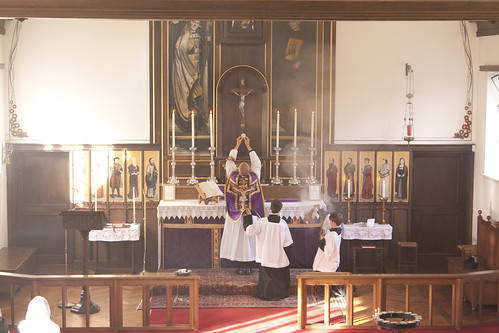 |
| Mass of reparation in Oxford: Votive Mass pro remissione peccatorum |
'Look not upon me', says the Beloved, the Church. 'For the sun hath looked upon me.' Labouring in the vineyard has darkened her skin; she is conscious that her beauty is hidden. She says: 'I am black but beautiful'. (Song of Songs, 1:5, 4)
Christ also, the spotless Lamb, was disfigured, by his enemies. Isaiah says of Him in prophecy: 'there is no beauty in him, nor comeliness: and we have seen him, and there was no sightliness, that we should be desirous of him' (Is 53:2). But again, Christ's beauty is hidden, rather than lost.
What has happened to the Church in the last 50 years and more is a disfigurement, a disgrace. Like the Beloved of the Song of Songs, the Church has been cast out of doors without her veil:
'The watchmen that went about the city found me, they smote me, they wounded me; the keepers of the walls took away my veil from me.' (Song 5:7)
The defilement of the Church is real in one sense, and only apparent in another. As a human institution she can be wounded and shamed. As a divine institution she cannot. She is both human and divine, a mirror of Christ, who in His humanity truly suffered and died. This suffering was not unreal or superficial: the betrayal, the stripping naked, the being spat upon, the being tortured and killed. It is profoundly real and of the greatest significance. And yet Christ in his Divine nature, and the Church as the Mystical Body and Bride of Christ, is not defiled: such a thing is impossible. She remains beautiful, though blackened.
This paradox is the consequence of the Incarnation, and the way the Incarnation is continued in the Church as the Mystical Body of Christ. Something with a physical, personal, human manifestation in the world is susceptible to attack, wounding, and disgrace. You can't have an incarnational theology without this consequence.
One might object that, in the case of the Church, the most important wounds are self-inflicted. However, it is not the Mystical Body as such which causes the wounds; it is her human members when they fail to act as members. When we engage in the Public Prayer of the Church we act as one with the Mystical Body and offer to God a perfect act of Worship which only the Mystical Body of Christ, that is, only Christ Himself, can offer. When we (bishops, priests, laymen) perform sacramental actions, it is the action of Christ through his Mystical Body. When we commit some hideous sacrilege it is not. It is a wound we give to the Mystical Body, against the Mystical Body.
The Mystical Body is not a pure, spiritual thing which can only be seen with the eyes of Faith. It has a real, human, historical, manifestation. This manifestation can make it as vulnerable to profanation as the manifestation of the Body of Christ in the Blessed Sacrament. But while those who profane the Blessed Sacrament do something serious, because Christ is truly present there, they do not harm Christ. At the Last Judgement, when wicked Catholics, including priests, bishops, and popes, are tossed into Hell, the Church, as the Bride of Christ, will be presented to her Lord as a spotless virgin (2 Corinthians 11:2).
The relationship between Christ's Divine and Human natures is, notoriously, not easy to explain: it is a mystery. That is, we can understand a number of things about it, things we must say and things we must deny about it, but we cannot fully grasp its internal logic. The same is true of the relationship between the human and divine aspects of the Church. I must leave it as something of a paradox. But it is paradox we must believe.
What we believe about the Church has the consequence that we are right to be angry, as well as bitterly grieved, about the clerical abuse revelations. This anger is not simply a justified emotional reaction, it is a duty. Anger is a desire for justice, and we must do what we can to secure justice in this case. This may well mean being less polite than we were wont to be, less inclined to overlook things, less generous with our money and volunteering: in a careful, systematic, persistent, and thought-through way.
What is not right would be to take the occasion to doubt the Church's divine institution. The good works of the Church's members, it is true, might be a consideration in her favour, and evil works obviously count the other way. However, the Church's divine nature is manifested above all in the liturgy, the sacraments, and the perennial teaching which is guided by the Holy Spirit. My Catholic readers know what I mean when I say that as Catholics we know this deep down. We have experienced the consolation of the liturgy. We have experienced Christ's forgiveness in confession. We know that the Real Presence is not make-believe: it is a supernatural fact that impinges insistently on the material world, in our lives, and in the lives of others. We cannot let the defilement of the Mystical Body lead us to doubt the purity of the Mystical Body, odd as that might seem. The Satanist who defiles the Blessed Sacrament does not make it less holy. His actions are, in fact, a testimony to that holiness, which he recognises and hates.
Satanists hate holy things because they have turned away from God and are enraged by the concrete possibility of goodness which they have rejected. They wish to tear it down to their own level of filthiness. It is said that paedophiles feel similarly about the innocence of children. Today's focus is on the bishop-enablers. What were they thinking? Certainly they were not motivated by reverence and love for what is holy and for the innocent. The crushing worldliness of the episcopal attitude, the managerialism, is striking, but it does not explain actions which were often irrational and self-defeating from a worldly point of view. Those who see something demonic here are correct. What we see is a brutal carelessness, of brushing things aside, which reflects a rejection of the categories of holiness and innocence. They may have thought they believed the Faith, some of them, but at some level they did not. Not just in moments of high emotion, not just under intense temptation, but calmly, deliberately, day after day, year after year, in case after case, they rejected celibacy, they rejected the holiness of the sacraments, and they crushed innocence in the mortar.
Catholic activists have seen this before. Those concerned with pro-life issues, liturgical abuses, Catholic education, or the Traditional liturgy, all have had experiences over 50 years exactly parallel with the experiences of the victims and parents of victims of clerical abuse. Buck-passing, contempt for faithful Catholics, appeals to clerical and episcopal dignity and authority, the toleration and imposition of injustices, and outright lies. Such Catholics were the only audience for the early denunciations of clerical abuse, when the secular media weren't listening. They read Michael Rose's Goodbye Good Men, which was published in 2002, while liberal and neo-conservative Catholics choked with rage that bishops and priests could be criticised. What Rose described, the anti-celibate and specifically homosexual culture of seminaries, was made possible by a culture of aggressive destruction of the holy, of devotions and buildings and doctrine and pious practices, and of the people who defended them, which these activist Catholics had read about in Ann Carey's Sisters in Crisis in 1997, and all the books and pamphlets of Michael Davies, Dietrich von Hildebrand, Anne Roche Muggeridge, Fr Bryan Houghton, and many others in the 1980s and 1970s. Such Catholics were the only audience for discussions of the prophecies of Our Lady of Salette, of Akita, of Quito, and of Fatima, which pointed to the culmination of modernism and secularism within the Church in a massive crisis of apostasy and sacrilege in the later part of the 20th century. Well, all that stuff doesn't look so stupid now, does it?
This is a crisis fundamentally of the Faith. Outside the Church and inside, those who permit and even promote this kind of abuse from positions of authority are those who hate the Faith. They may like lace and watered silk: most do not, but some do. But they all hate the Faith where it impinges on their desires, they hate those people and things which represent to them the possibility of repentance, and they want bring down to their own level of sordid carelessness the innocent.
What we need are, simply, bishops who do not have this hatred, and have the courage to confront and uproot it. All kinds of pressure and strategies are worth exploring, but some devils can only be cast our by prayer and fasting. As well as the practical things, we have a duty to make reparation.
There is still time to sign up to the Walsingham Pilgrimage. But whatever you do, join me in doing something in reparation for this abyss of filth which has been revealed. God will hear us.
Support the work of the LMS by becoming an 'Anniversary Supporter'.
Appeal to the Cardinals over the Death Penalty
An unprecedented appeal to the College of Cardinals
In an unprecedented move, 45 Catholic academics and clergy have signed an Appeal to the Cardinals of the Catholic Church, urging the cardinals to tell Pope Francis that he must teach the authentic Catholic doctrine concerning capital punishment. The appeal follows an addition to the Church’s Catechism announced by Pope Francis on August 2nd. The new paragraph, which is confusingly worded, has been taken by many inside and outside the Church to say that capital punishment is intrinsically immoral, and must never be used. Such a teaching would run contrary to many passages in the Bible, and to the teaching of the Church down the centuries.
Catholics hold that while a pope has the right to clarify matters of faith and morals, he has no right to introduce new doctrines, or to contradict what the Church has always believed. They likewise hold that a pope must not seek to impose his private opinions on the faithful. The petition, which has been signed by professors of philosophy, theology, law, and history from Catholic institutions across the world, and by priests from several countries, calls on the cardinals to advise the pope that he must withdraw the offending paragraph, and that he must not ‘adulterate the word of God’. It also advises the cardinals that they have a serious obligation to warn the pope in this way, in order not to fail in their own duty toward God and the Church.
The petition does not insist that capital punishment must always be used in practice for the worst crimes, since this is a matter which Catholic may freely debate. It insists on the legitimacy of the death penalty in principle.
According to the Church’s own law, competent Catholics “have the right and even at times the duty to manifest […] their opinion on matters which pertain to the good of the Church and to make their opinion known to the rest of the Christian faithful” (Code of Canon Law, Canon 212). St Thomas Aquinas, considered a model for Catholic theologians, likewise held that: “If the faith were endangered, a subject ought to rebuke his prelate even publicly.”
The petition has been sent to the cardinals, because they are traditionally considered to be the pope’s own counsellors. There are currently 224 cardinals in the world.
For further information, contact Dr Joseph Shaw:
joseph.shaw99@gmail.com


